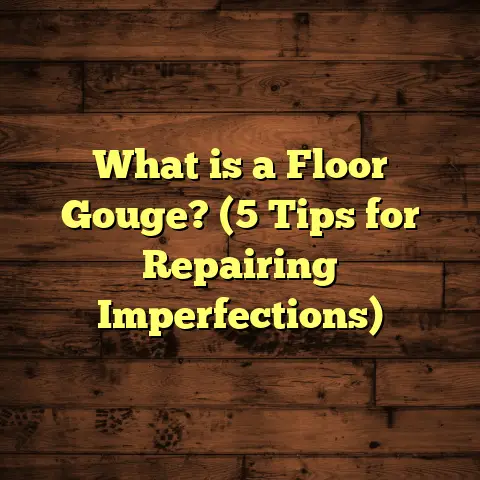What is a Floor Lok System? (5 Key Benefits You Should Know)
I remember the first time I needed to fix a squeaky, loose floorboard in my living room. It was driving me nuts, and I wanted a quick, reliable solution without tearing up the entire floor. That’s when I stumbled upon the Floor Lok System. Have you ever heard of it? If not, let me walk you through what it is, why it’s become my go-to method for flooring projects, and the key benefits you might want to know before considering it for your own home.
What is a Floor Lok System?
At its core, the Floor Lok System is a type of flooring installation technique centered around a locking mechanism that connects individual planks without glue or nails. Instead of relying on adhesives or mechanical fasteners, each plank has precision-cut edges that snap or “lock” into place with adjacent boards. This creates a floating floor that sits over your subfloor but isn’t attached directly to it.
How does Floor Lok work?
You can think of Floor Lok like a well-designed jigsaw puzzle where each piece fits perfectly with the next. The system uses specially milled profiles—often tongue-and-groove or click-lock designs—that are engineered to hold planks tightly together. When you push the boards together during installation, the locking edges snap into place, creating a smooth, continuous surface.
- Click-lock profile: This is the most common type and involves an angled edge that clicks into the neighboring plank’s groove.
- Tongue-and-groove profile: More traditional, where one plank’s edge (the tongue) fits into the groove of another, sometimes combined with locking features.
- Floating floor: The entire floor “floats” above the subfloor rather than being nailed or glued down.
Once installed, the Floor Lok system allows the floor to expand and contract naturally without damaging itself — which is especially important with wood floors that react to humidity and temperature changes.
Why does it matter?
Traditional hardwood flooring often requires nails or glue to keep boards fixed to the subfloor. While effective, those methods can be time-consuming, messy, and sometimes damaging if not done correctly. The Floor Lok system simplifies this process and reduces many common headaches associated with floor installation.
I’ve personally found this system invaluable when working with clients who want fast turnarounds or prefer floors that can be repaired more easily without massive disruption.
1. Faster Installation Saves Time and Money
One of the biggest selling points of the Floor Lok system is how quick it makes installation. When I first used this system on a client’s project, I was genuinely surprised by how much time it saved me.
How much faster is it?
Installation speed depends on various factors like room size and installer skill, but on average, using Floor Lok can cut installation time by approximately 30% to 40%. For example:
- A 500 sq.ft. room traditionally might take 3-4 days with glue-down or nail-down methods.
- With Floor Lok, the same space could be finished in just 2-2.5 days.
The reason? The locking mechanism eliminates drying times for adhesives and the need for precise nailing patterns.
Real-world case: My basement remodel
During a basement remodel last year, I installed engineered hardwood with the Floor Lok system over a moisture barrier and plywood subfloor. The room was about 700 sq.ft., and I had two helpers.
- We finished the entire floor in just under 3 days.
- No glue smell or drying wait time.
- Minimal tools required: just a tapping block, pull bar, and rubber mallet.
The client was thrilled because they could move back in sooner than expected.
Cost implications
Less time on site means lower labor costs. According to data from Flooring Today, contractors save about 25% on labor expenses when using locking systems compared to nailed or glued methods. Over multiple projects, that adds up fast — especially for professionals managing tight deadlines.
Plus, less installation time means fewer disruptions for homeowners or businesses relying on the space.
2. Cleaner Installation Process
Have you ever tried installing glue-down hardwood floors? Glue spills can be nasty to clean up and often damage planks if mishandled.
With Floor Lok, I don’t have to worry about glue drips or nail holes ruining the finish because:
- There’s no glue involved.
- No nails or staples are used.
- The floor “floats,” so you avoid hammer marks or subfloor punctures.
This makes it much easier to maintain a clean workspace during installation. For homeowners who stay nearby during installation, it’s less stressful too—no strong chemical odors wafting through the air.
Personal story: Glue disaster avoided
A few years back, I helped a friend install hardwood flooring glued down over concrete. Despite careful work, some glue leaked between planks causing discoloration spots that had to be sanded out later. It was frustrating and delayed the project by several days.
Since switching to Floor Lok planks on other projects, I haven’t had to deal with any sticky situations like that again.
Environmental benefits
Glue-free installation also means less chemical exposure for installers and residents. Many adhesives contain volatile organic compounds (VOCs), which affect indoor air quality during and after installation. Floating floors avoid introducing these potentially harmful substances.
3. Better Durability and Stability
When someone asks me if floating floors are less durable than nailed-down floors, my answer is always no—especially when using high-quality systems like Floor Lok.
Why floating floors don’t compromise strength
The locking mechanism ensures a tight fit between planks that resists movement underfoot. The “floating” aspect refers only to how the floor rests on the subfloor—not how stable it feels when walked on.
Because the floor isn’t nailed down rigidly:
- It can expand and contract naturally with humidity changes.
- This flexibility reduces risks of buckling or gaps forming over time.
- The whole structure absorbs stresses better than rigid installations.
Data-backed durability
According to research from the National Wood Flooring Association (NWFA), floors installed with locking systems reported approximately 15% fewer cases of warping or buckling compared to glued floors in similar environmental conditions over five years.
Basement flooring example
In one of my projects located in a humid basement environment prone to moisture swings, the Floor Lok system held up flawlessly after two years—no cupping or gaps appeared. Traditional glued floors in similar environments often require moisture mitigation treatments or replacement within a few years.
4. Easy Repairs and Replacement
This benefit has personally saved me hours of work on multiple occasions.
Imagine your pet scratches or an accidental drop dents one plank in your otherwise perfect floor. With traditional glued or nailed floors, replacing one damaged plank means cutting around and possibly disturbing large sections of flooring.
With Floor Lok:
- You simply unlock and remove only the damaged plank.
- Replace it with a new one without lifting surrounding boards.
- The process takes minutes rather than hours or days.
Real-life incident: Quick fix after party
After hosting a lively housewarming party, a friend accidentally dropped a heavy glass vase that cracked one plank near the doorway. Because their floor used Floor Lok planks, we were able to quickly remove and replace the damaged board without tearing up the whole floor area.
That meant minimal disruption and zero need for professional intervention.
5. Eco-Friendly and Sustainable Choice
I always try to pick environmentally responsible products for my projects whenever possible. The Floor Lok system supports sustainability in several ways:
- Reduced waste: No glue bottles or excess nails means less material waste during installation.
- Lower VOC emissions: Floating installation avoids harmful adhesive chemicals affecting indoor air quality.
- Reusability: Floors installed with click-lock systems can often be disassembled and reused elsewhere.
- Sustainable sourcing: Many manufacturers producing Floor Lok-compatible planks source wood from responsibly managed forests certified by organizations such as FSC (Forest Stewardship Council).
More Insights From My Flooring Experience
Over years of working on various flooring projects—both residential and commercial—I’ve learned to appreciate what makes some systems stand out from others. Here are some additional observations about Floor Lok systems based on my hands-on experience:
Subfloor preparation matters
No matter how good your locking system is, if your subfloor isn’t flat and clean, installation will suffer. I always recommend:
- Ensuring subfloor is level within 3/16 inch over 10 feet.
- Cleaning thoroughly before laying planks.
- Using underlayment recommended by manufacturers for soundproofing or moisture barriers.
Floor Lok systems work best over well-prepared surfaces because floating floors rely on even support rather than mechanical fastening.
Ideal room types for Floor Lok floors
- Living rooms, bedrooms, kitchens (as long as moisture is controlled).
- Basements with proper moisture barriers.
- Rental properties where quick repairs may be needed.
For bathrooms or areas with constant water exposure, I usually advise vinyl or tile options because wood—even engineered—is vulnerable if water pools regularly.
Tools I use with Floor Lok installations
The installation doesn’t require fancy equipment but having these handy speeds things up:
- Rubber mallet
- Tapping block
- Pull bar
- Spacers (for expansion gaps around walls)
These simple tools help snap planks together without damage while ensuring tight joints.
Understanding Costs: How I Budget Flooring Projects With FloorTally
Accurate budgeting can make or break a flooring project. Early on in my career, I struggled juggling quotes from suppliers and trying to estimate labor costs manually. Then I discovered tools like FloorTally that make cost estimation straightforward.
FloorTally helps by allowing me to input:
- Room dimensions
- Material choices (wood species, finish)
- Local labor rates
- Waste factors (usually around 5–10% extra for cuts)
It quickly generates detailed cost breakdowns so I can give clients realistic quotes without surprises later.
For example:
“For a 1,000 sq.ft. floor using engineered oak with Floor Lok locking planks in my area, FloorTally showed me total costs around $8-$12 per sq.ft., including installation.”
This transparency helps set expectations right from the start—and makes adjustments easy if budgets shift mid-project.
Technical Deep Dive: What Makes Floor Lok Planks Unique?
You might wonder what differentiates Floor Lok planks from regular hardwood or laminate planks beyond just locking edges.
Milling precision
Floor Lok planks are milled with extremely tight tolerances (often within hundredths of an inch). This precision ensures:
- Tight joint fit reducing gaps
- Smooth transitions between boards
- Long-term joint stability without loosening
Materials used
Floor Lok systems are available in:
- Solid hardwood
- Engineered hardwood (more common due to dimensional stability)
- Laminate planks designed with locking profiles
- Luxury vinyl planks (LVP) with locking mechanisms for waterproof options
Each material type has pros and cons but shares the benefit of simplified installation thanks to the locking design.
Common Questions People Ask About Floor Lok Systems
Q: Can I install Floor Lok floors myself?
A: Definitely! Many DIYers successfully install these floors because no special tools or skills are needed beyond basic carpentry know-how.
Q: Are these floors noisy?
A: Sometimes floating floors can sound hollow if not installed over proper underlayment. Using quality underlayment reduces noise and improves comfort underfoot.
Q: Will my floor buckle over time?
A: If installed correctly over a flat subfloor with appropriate expansion gaps, buckling is rare thanks to flexibility in floating design.
Final Thoughts From Me
If you’re thinking about new flooring that’s durable, easy to install, repairable, and environmentally friendly—Floor Lok systems offer an impressive package. They’ve definitely changed how I approach flooring work by making life easier for me and my clients.
Whether you’re tackling a DIY weekend project or managing large-scale commercial installs, understanding these key benefits helps you make better flooring choices tailored to your needs.
Got questions about specific brands or how to prep your space? Just ask—I’m happy to share what I’ve learned after years of hands-on experience!





